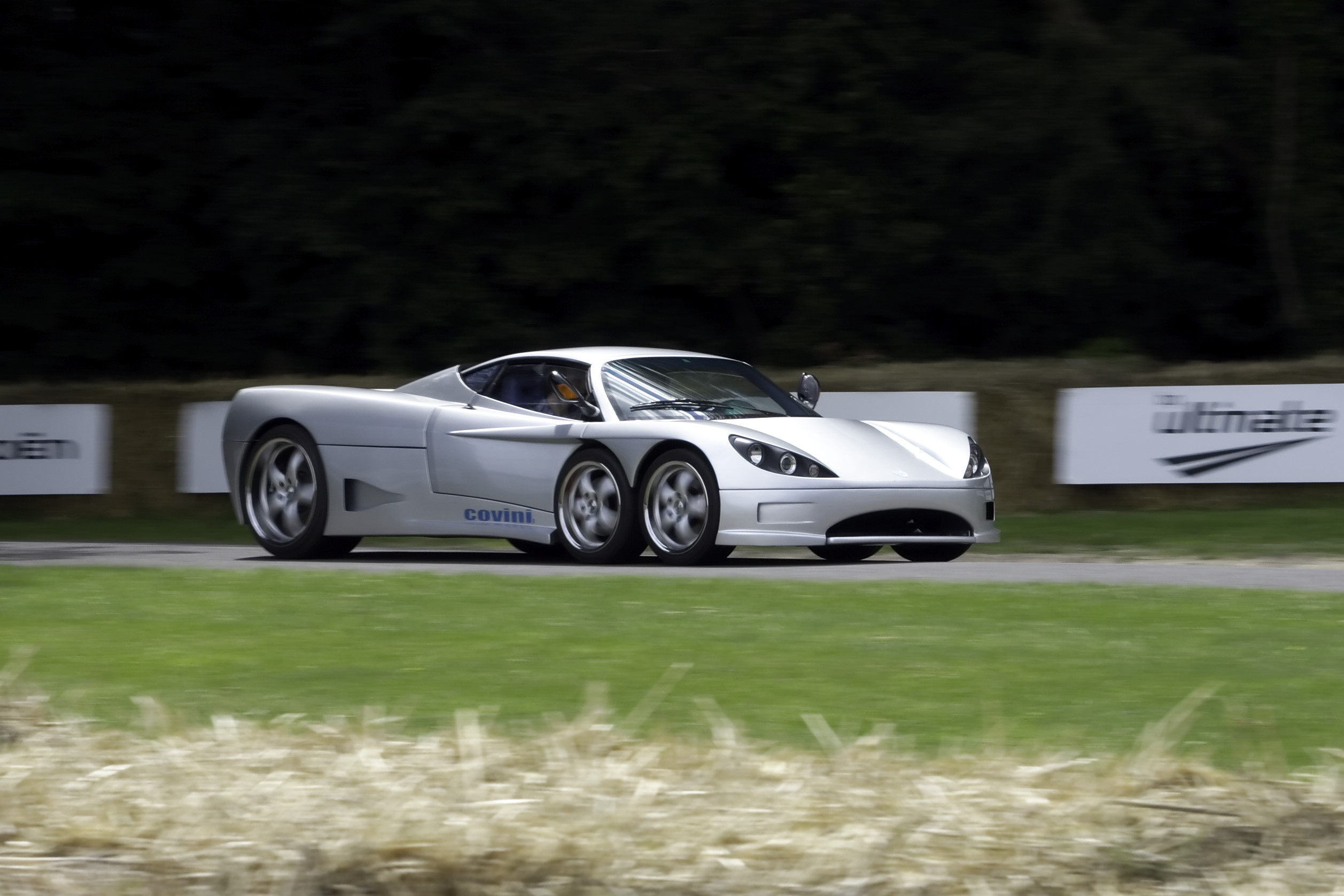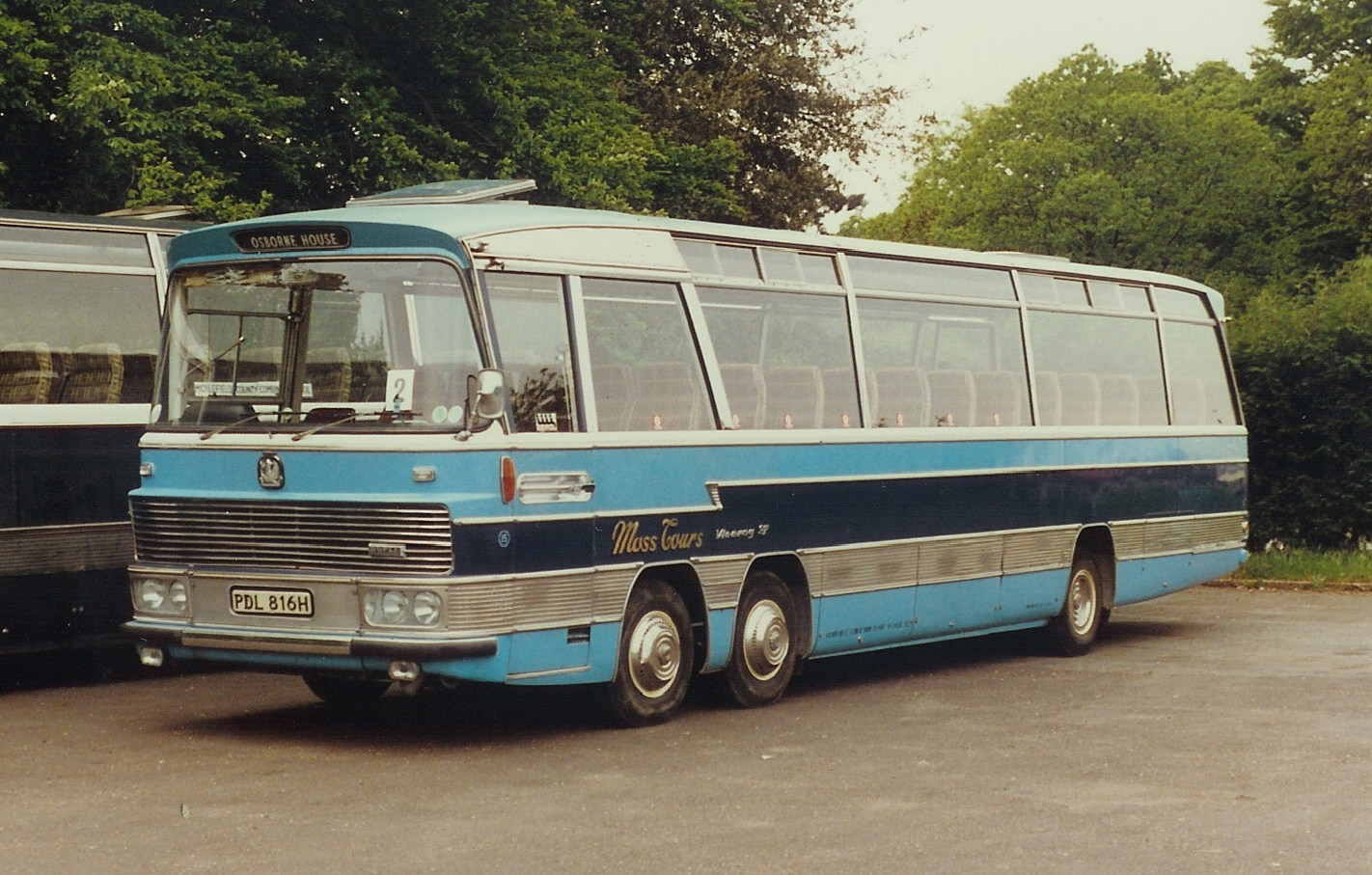|
Ford Seattle-ite XXI
The Ford Seattle-ite XXI was a 3/8 scale concept car designed by Alex Tremulis and displayed on 20 April 1962 on the Ford stand at the Seattle World's Fair. Description The car contained novel ideas that have since become reality: interchangeable fuel cell power units; interchangeable bodies; interactive computer navigation, mapping, and auto information systems; and four driving and steering wheels. The concept of some form of compact nuclear propulsion device was included as a possible power source on the assumption that radiation issues could be overcome without the need for prohibitively bulky shielding. The car had six wheels, with four steerable ones at the front and two fixed ones at the rear – similar to the fictional six-wheel 1965 FAB1 and the real Tyrrell P34 racing car of the mid-1970s. The designers determined the six-wheel concept would enhance tracking, traction, and braking. It had an interchangeable front-powered section that enabled the car to be turned into ... [...More Info...] [...Related Items...] OR: [Wikipedia] [Google] [Baidu] |
Concept Car
A concept car (also known as a concept vehicle, show vehicle or prototype) is a car made to showcase new styling and/or new technology. They are often exhibited at motor shows to gauge customer reaction to new and radical designs which may or may not be mass-produced. General Motors designer Harley Earl is generally credited with inventing the concept car, and did much to popularize it through its traveling Motorama shows of the 1950s. Concept cars never go into production directly. In modern times all would have to undergo many changes before the design is finalized for the sake of practicality, safety, regulatory compliance, and cost. A " production-intent" prototype, as opposed to a concept vehicle, serves this purpose. Design Concept cars are often radical in engine or design. Some use non-traditional, exotic, or expensive materials, ranging from paper to carbon fiber to refined alloys. Others have unique layouts, such as gullwing doors, 3 or 5 (or more) wheels, or spe ... [...More Info...] [...Related Items...] OR: [Wikipedia] [Google] [Baidu] |
Alex Tremulis
Alexander Sarantos Tremulis (January 23, 1914 – December 29, 1991) was a Greek-American industrial designer in the North American automotive industry. Tremulis held automotive design positions at Cord Automobile, Duesenberg, General Motors, Tucker Car Corporation and Ford Motor Company before establishing a consulting firm. Early career Tremulis was the son of Greek immigrants. His parents were Antonia and Sarantos Tremulis, who came from a village near Sparta. As a 19-year-old and without any formal training in art or engineering, he landed a job on the design team for the Auburn-Cord-Duesenberg Company in 1933. Among his projects were the now famous and classic Cord 810 and 812 series, as well as a custom Duesenberg roadster having both convertible and hardtop options. In 1936, he was named Chief Stylist for Auburn-Cord-Duesenberg, and remained in that role until the company failed in 1937. Tremulis briefly worked for General Motors before moving to Briggs-Le Baron, a custom ... [...More Info...] [...Related Items...] OR: [Wikipedia] [Google] [Baidu] |
Ford Motor Company
Ford Motor Company (commonly known as Ford) is an American multinational automobile manufacturer headquartered in Dearborn, Michigan, United States. It was founded by Henry Ford and incorporated on June 16, 1903. The company sells automobiles and commercial vehicles under the Ford brand, and luxury cars under its Lincoln luxury brand. Ford also owns Brazilian SUV manufacturer Troller, an 8% stake in Aston Martin of the United Kingdom and a 32% stake in China's Jiangling Motors. It also has joint ventures in China (Changan Ford), Taiwan (Ford Lio Ho), Thailand ( AutoAlliance Thailand), and Turkey ( Ford Otosan). The company is listed on the New York Stock Exchange and is controlled by the Ford family; they have minority ownership but the majority of the voting power. Ford introduced methods for large-scale manufacturing of cars and large-scale management of an industrial workforce using elaborately engineered manufacturing sequences typified by moving assembly lines; by ... [...More Info...] [...Related Items...] OR: [Wikipedia] [Google] [Baidu] |
Century 21 Exposition
The Century 21 Exposition (also known as the Seattle World's Fair) was a world's fair held April 21, 1962, to October 21, 1962, in Seattle, Washington (state), Washington, United States.Guide to the Seattle Center Grounds Photograph Collection: April, 1963 , University of Washington Libraries Special Collections. Accessed online October 18, 2007. Nearly 10 million people attended the fair.Joel Connelly Century 21 introduced Seattle to its future , ''Seattle Post-Intelligencer'', April 16, 2002. Accessed online October 18, 2007. As planne ... [...More Info...] [...Related Items...] OR: [Wikipedia] [Google] [Baidu] |
Tyrrell P34
The Tyrrell P34 (Project 34), commonly known as the "six-wheeler", was a Formula One (F1) race car designed by Derek Gardner (designer), Derek Gardner, Tyrrell Racing, Tyrrell's chief designer. The car used four specially manufactured 10-inch diameter (254 mm) wheels and tyres at the front, with two ordinary-sized wheels at the back. Along with the Brabham BT46, Brabham BT46B "fancar" developed in , the six-wheeled Tyrrell was one of the most radical entries ever to succeed in F1 competition and has been called the most recognisable design in the history of world motorsports. The P34 was introduced in September 1975 and began racing in the 1976 Formula One season, 1976 season. It proved successful and led other teams to begin design of six-wheeled platforms of their own. Changes to the design made for the 1977 Formula One season, 1977 season made it uncompetitive and the concept was abandoned for Tyrrell's 1978 season. The other six-wheeled designs ended development and F1 ru ... [...More Info...] [...Related Items...] OR: [Wikipedia] [Google] [Baidu] |
Covini C6W
The Covini C6W is an Italian 2-seat 2-door sports coupé with a removable roof section. Inspiration for the car was taken from the 1976 Tyrrell P34, which had two pairs of smaller front wheels, a principle applied to the C6W. The project was started in 1974 but abandoned shortly after, and left dormant into the 1980s due to the lack of availability of low-profile tires at the time. In 2003 the project was revived and in 2004 the C6W was shown in prototype form. In 2005 a slightly revised version debuted at the Salon International de l'Auto, featuring new wheels, new roof structure and a refreshed interior, and went into limited production of 6-8 cars per year, as a result of a tie-up between PMI and Covini Engineering. The car features a rear, 4200 cc 8-cylinder engine and has a top speed of . Construction *Drive wheels: RWD *Construction: Fiberglass and carbon fiber body over tubular steel frame *Front brakes: Brembo disc brakes, with ABS *Fuel feed: Direct petrol injection *I ... [...More Info...] [...Related Items...] OR: [Wikipedia] [Google] [Baidu] |
FAB 1
FAB 1 is a pink, six-wheeled car seen in the 1960s British science-fiction television series '' Thunderbirds'', its three film adaptations and its reboot, '' Thunderbirds Are Go''. Depiction 1960s TV series and films In the original '' Thunderbirds'' (1965–66), as well as the feature films '' Thunderbirds Are Go'' (1966) and ''Thunderbird 6'' (1968), FAB 1 is depicted as a modified Rolls-Royce. Owned by International Rescue agent Lady Penelope Creighton-Ward, the car is usually driven by her butler, Aloysius Parker. The driver sits in a central position at the front of the passenger compartment, which is covered by a bulletproof bubble canopy. FAB 1 was modified by Brains, the inventor of the ''Thunderbirds'' machines, to include weaponry and gadgetry such as front- and rear-mounted machine guns (although grappling hooks are seen to shoot out of the rear in the episode "The Perils of Penelope"). The car is also equipped with a smoke screen canister and oil slick dispenser ... [...More Info...] [...Related Items...] OR: [Wikipedia] [Google] [Baidu] |
Panther 6
The Panther 6 was a British six-wheel convertible produced by Panther in 1977. The car is powered by a mid-mounted Cadillac V8 engine with twin turbochargers paired to a three-speed automatic transmission. Only two cars were made (one in white, one in black), both of which are known still to exist. One is in Saudi Arabia, and the other was shown at the 2008 NEC Classic Car Show by the Panther Car Club and at the 2015 Concorso d'Eleganza Villa d'Este by Albert Fellner. The six-wheel configuration was inspired by the Tyrrell P34 racing car. The layout consists of one pair of larger rear wheels with Pirelli 265/50VR16 tyres, and two pairs of smaller steerable front wheels with Pirelli 205/40VR13 tyres. The specification included a detachable hard top and convertible soft top, electronic instruments, air conditioning, an automatic fire extinguisher, electric seats and windows, a telephone and a dashboard-mounted television set. Claims for the top speed of this vehicle suggested i ... [...More Info...] [...Related Items...] OR: [Wikipedia] [Google] [Baidu] |
Bedford VAL
The Bedford VAL is a type of coach chassis that was built by Bedford in the United Kingdom from the mid-1960s to the early 1970s. It was unusual at the time for its multi-axle design, in a " chinese six" wheelplan, i.e. with two front steering axles. Originally it was fitted with the Leyland O.400 straight six diesel engine. With this engine, the chassis was designated VAL14. Over 900 VAL14s were built, from 1963 to 1966, with the largest orders coming from Wallace Arnold of Leeds, Seamarks of Westoning, Don Everall of Wolverhampton, and Bartons. From 1967, the VAL70, with the slightly larger engine of Bedford's own manufacture, quickly superseded the VAL14. Bodywork The VAL was built with a number of bodies from different coachbuilders. The majority of VAL14s were of Duple or Plaxton origin, although VAL14s were also bodied by several other manufacturers, including Harrington ( Harrington Legionnaire bodywork was adopted) and Yeates. Some VAL14s were given bus body ... [...More Info...] [...Related Items...] OR: [Wikipedia] [Google] [Baidu] |
Ferrari 312T
The Ferrari 312T was a Ferrari Formula One car design, based on the 312B3 from 1974. In various versions, it was used from 1975 until 1980. It was designed by Mauro Forghieri for the 1975 season, and was an uncomplicated and clean design that responded well to mechanical upgrades. The 312T series won 27 races, four Constructors' and three Drivers' Championships, making it the most successful car design in Formula One history. It was replaced for the 1981 season by the 126 C, Ferrari's first turbocharged F1 car. It was also Ferrari's last naturally-aspirated F1 car until the Ferrari 640 in 1989, after the ban on turbocharged engines. Mechanical configuration The car was powered by the powerful and reliable ''Tipo'' 015 flat-12 engine which gave around 510 bhp. Although it had to carry more fuel, oil and water than the Cosworth DFV-powered cars the power-to-weight ratio of the flat-12 was about the same as the DFV. The "3" stood for the car's engine displacement ( ... [...More Info...] [...Related Items...] OR: [Wikipedia] [Google] [Baidu] |
March 2-4-0
The March 2-4-0 was an experimental six-wheeled Formula One racing car built by the March Engineering company of Bicester, UK. It was constructed in late 1976 and tested in early 1977. The car followed on from the successful use by Tyrrell Racing of a six-wheeled car, the Tyrrell P34, in Formula One racing. However, the engineering concept behind the 2-4-0 was quite different. Tyrrell P34: four wheels at the front The front wheels of an open-wheeled F1 car generate aerodynamic drag. The thinking behind the Tyrrell P34 was that this drag effect could be reduced by using smaller diameter tyres at the front. At the time, conventional F1 front wheels would measure around 16" (40 cm) diameter but Tyrrell planned to use just 10" (25 cm) diameter wheels. The corresponding loss of front-end grip was overcome by incorporating two front wheels per side thus actually increasing grip as well as decreasing drag. The design incorporated a system whereby all four front wheels c ... [...More Info...] [...Related Items...] OR: [Wikipedia] [Google] [Baidu] |






